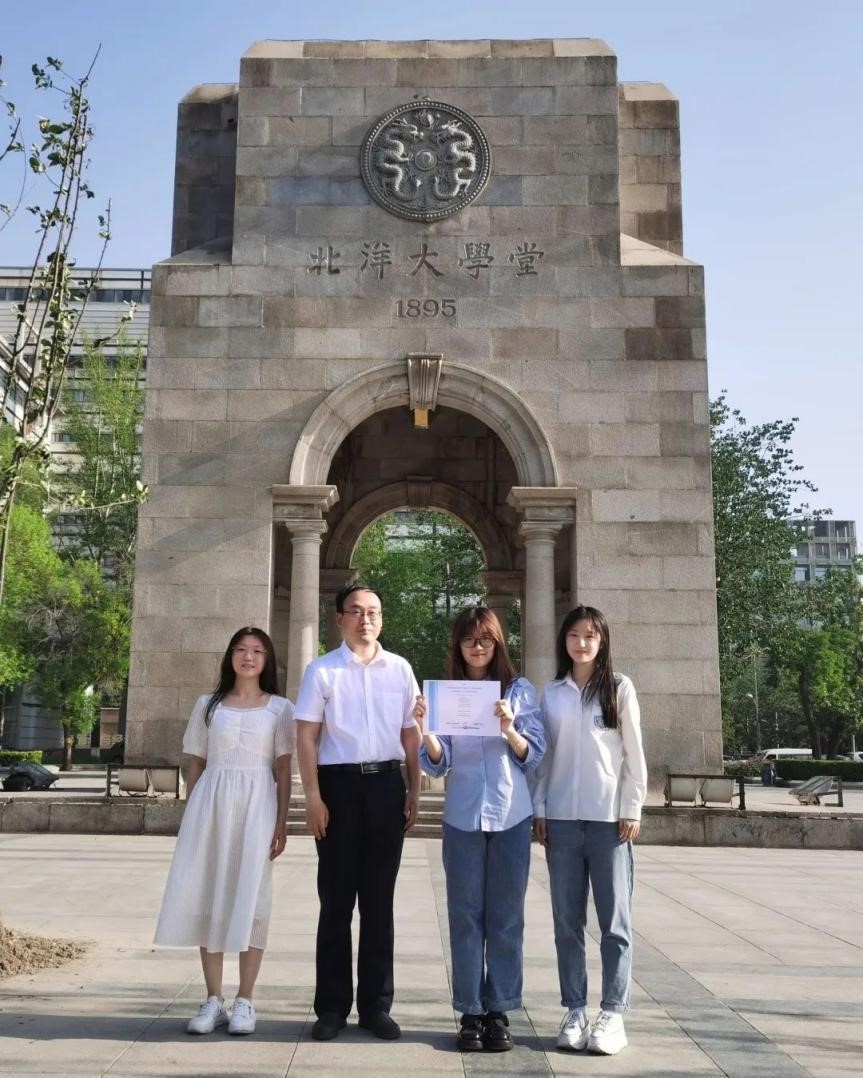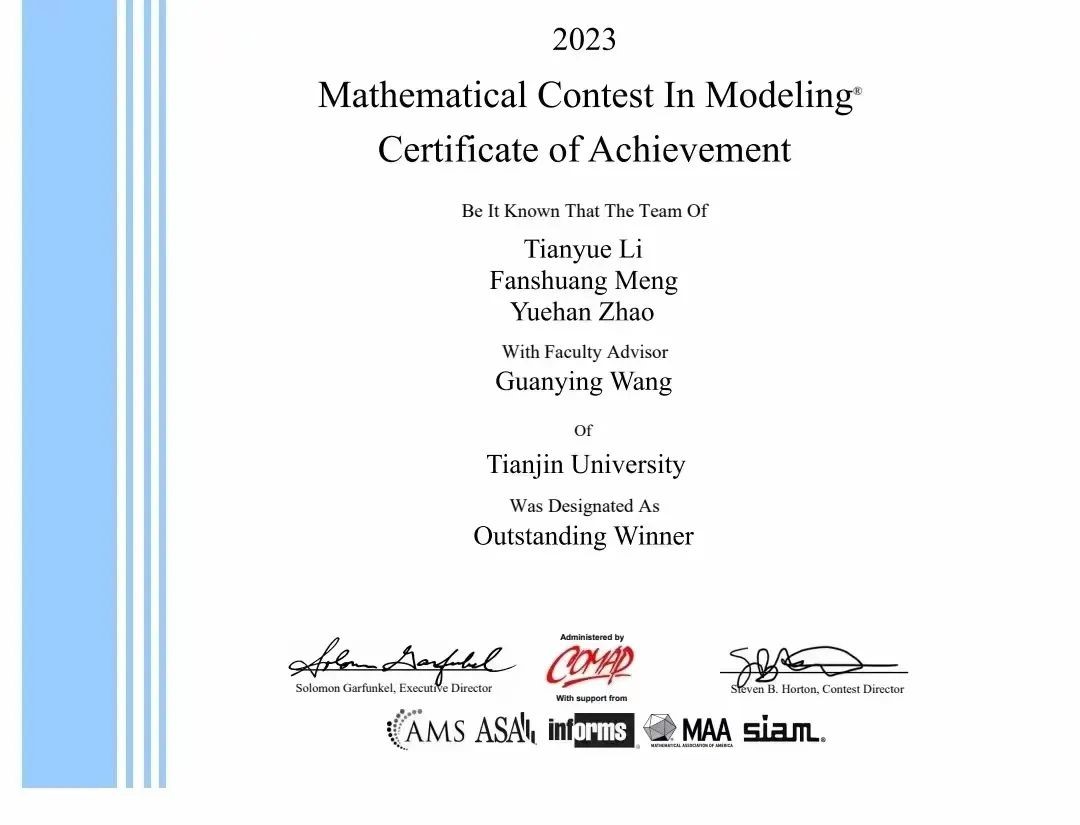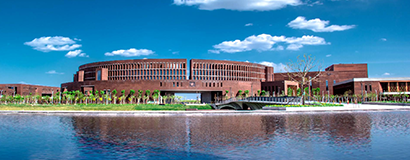On May 9, the results of the Mathematical Contest in Modeling (MCM/ICM) in 2023 were officially announced. Under the guidance of Associate Professor Wang Guanying from the College of Management and Economics (CoME) of Tianjin University (TJU), Li Tianyue and Zhao Yuehan, majoring in information management and information system, and Meng Fanshuang, majoring in finance, undergraduate students of the year 2020, won the highest honor (the top 0.15%) of the Outstanding Winner.

In 2023, there were 11,296 MCM teams and 9,562 ICM teams in the Mathematical Contest in Modeling, with a total of 20,858 teams participating. Among them, MCM had 22 teams, and ICM had 15 teams that have won the Global Grand Prize. 8,011 (71%) teams in MCM chose the C question, while only 12 teams worldwide chose the C question and won the award. Many of the global participating teams came from top domestic and international universities such as Harvard University, Princeton University, Massachusetts Institute of Technology, Tsinghua University, and Peking University, among others. TJU’s standing out in the fierce competition and achieving outstanding results showcased TJU students' ability to solve practical problems with mathematics and their spirit of innovation and exploration. This is the second time that TJU has won this honor in Mathematic Modeling in the US, and it is also the second consecutive year that it has won the Grand Prize.

The Mathematical Contest in Modeling (MCM/ICM) is an international competition for students from all over the world. It is the ancestor of all kinds of mathematical modeling competitions, which was first started in 1985. Jointly sponsored by the American Natural Science Foundation and the American Mathematical Application Association, and co-sponsored by the American Mathematical Society, the Operations Research Society, the Industrial and Applied mathematics Society and other institutions, it is the most influential international mathematical modeling competition in the world. The competition questions cover various fields such as economy, management, environment, resources, ecology, medicine, safety, and future technology, among others. Participating in the competition helps to enhance students' ability to solve practical problems using mathematical methods and writing skills, cultivate innovative spirit, and also help to exercise willpower and enhance team cooperation awareness.
Team members shared experiences and methods of participating the competition.
What stages did you go through during the preparation process?
What experiences and methods can be shared at each stage?
① Clear Direction: We first determined the scope of the topic based on the professional background of the team members, namely the C question for data analysis and the E question for environmental science. Then, we organized the model methods used in previous O Prize papers on the C&E two questions. Subsequently, we conducted a preliminary division of labor by combining "programming," "modeling," and "writing," with each person responsible for two directions of work.
② Special Study: Every day during our shared learning time, we watched math modeling teaching videos online and took notes together. In the rest of the time, we learned the skills required for our respective work, such as learning python programming, latex typesetting and data and information visualization methods, etc.
③ Research Topic: After completing the special study, we carefully studied the O Prize papers on previous years' C and E questions, learned the modeling methods and writing ideas of excellent works, and attempted to reproduce their codes and charts.
How to arrange time and coordinate cooperation during the competition?
①Schedule
Refuse to procrastinate or quit halfway. It is best to select two intended topics in advance based on the team's knowledge accumulation and experience, and finalize the questions as soon as possible in the morning after releasing the competition questions.
DAY1: Understand the question, collect literature, restate the problem, establish a basic model, and solve the first question;
DAY2: Complete the writing of the basic mode, continue to establish the core model for this question, and solve the answer;
DAY3: Analyze the remaining relatively simple problems and conduct sensitivity analysis;
DAY4: Complete the paper writing, jointly polish the paper (with a focus on the abstract), and use Latex layout.
Team members supervise each other, go to bed and wake up early every day, and work together offline to set daily task goals and ensure energy and work efficiency during the day.
② Coordination and cooperation
Li Tianyue was responsible for problem modeling and programming implementation, Zhao Yuehan was responsible for problem modeling and Data and information visualization, and Meng Fanshuang was responsible for conclusion analysis, paper writing and typesetting. During the competition, team members performed their respective roles, utilizing shared documents to synchronize progress and discussed issues in a timely manner. Continuous communication between the author and the modeler could ensure the direction and quality of the paper content.
What are the important strengths of your team?
The most important thing for a team is to not fall behind, move forward steadily, and be energetic at all times. We have a consistent goal and a strong sense of responsibility, and there were no inefficiencies or slacking off during the preparation process. Instead, we went all out to greatly increase the chances of success.
Secondly, the expertise and skills of finance and information management complement each other. The Information Management major is better at extracting and analyzing problems, establishing models, and programming algorithms to solve problems. Students in the Finance major are proficient in many econometric software, and are good at writing and typesetting English papers, covering core areas such as modeling, programming, writing, and typesetting. Team collaboration efficiency is very high.
By College of Management and Economics
Editor: Sun Xiaofang






